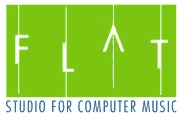Studio FLAT
A new studio for computer music at the University of Manitoba
Associate Professor in Composition, University of Manitoba
The facilities for electroacoustic music at the University of Manitoba will undergo a major upgrade during the summer 2007. The new studio will be located in the music building at the university, and will be named Studio FLAT. It will have a general approach to computer music, but an emphasis will be put on Computer Assisted Composition and activities in Interactive Computer Music will be included.
Facilities
The new studio will receive soundproofing treatment, both to optimize the listening environment and to allow for the possibility of using the studio as a recording space. Studio FLAT will be Macintosh based and support playback in 8.1 (eight loudspeakers and one subwoofer). All mixing will be done using control surfaces (Mackie Universal Controller with extension) and audio software will include Digital Performer with plug-ins from Waves, Audioease, Native Instruments and GRM. Software developed at IRCAM will be used for sound analysis and sound processing.
Max/MSP, Pd and Supercollider will be supported for productions in Interactive Computer Music. A variety of sensors, interfaces (among others the Kroonde wireless interface from La Kitchen), and input devices (the MalletKAT MIDI marimba, the Yamaha WX5 wind controller, the Moog piano bar and the Jazz Mutant Lemur control surface) will be available.
Activities in Computer Assisted Composition will be supported with the PatchWorkGL and OpenMusic graphical music-programming environments. Lisp programming tools from LispWorks and Digitool will mainly be used.
Activities
The activities in Studio FLAT can be divided into music production and computer music research. Music production will result in concerts inside and outside the university. Computer music research will influence the music being programmed on the concerts.
The core group working in the studio will be faculty members and composition students at the university. One of our goals, however, is to involve not only composition majors, but interested music majors in general. By involving performers the experience of new concert situations will reach outside the composer group. Collaborations with other faculties will make cross-disciplinary projects possible.
Music Production
The facilities will allow production of pure electroacoustic music as well as interactive computer music, with or without instruments. A relatively large amount of input devices and sensors make it possible to try different solutions for live-interaction with acoustic instruments. Another possible compositional strategy will be to use input devices to control sound synthesis. Using controllers like the Yamaha WX5 makes it possible to design a new instrument but to still use the skill of a trained performer.
Computer Assisted Composition can also result in the production of pure instrumental music. The music score will in this case be composed with the help of computerized calculations and/or sound analysis. Modeling of advanced orchestration techniques will also be possible.
Research
An important idea with the facility is to enable research in computer music composition at the University of Manitoba. The research will focus on modeling musical structures. The objective of the research will be to develop new methods for music composition and to find new ways to structure the interaction between musical parameters in a meaningful way (i.e. pitch, rhythm, harmony, metric structures, gestures, etc).
Already today research in Computer Assisted Composition is going on at the University of Manitoba. The author of this article does research on how to structure music using a rule-based computer system. Rules have been used to explain music theory for several hundred years, and theorists have managed to let computers imitate musical styles by using a rule-based computer system. The research at the University of Manitoba is not involved in style imitation. Instead an important objective is to explore new ways of formulating music rules to control music structures for the purpose of aiding the music composition process. The aim is not necessary to simplify the compositional process, but to find new possibilities in music composition. As a result of the research a prototype for a system for applying rules on multi-dimensional music structures exists today (coded in Lisp). Several compositions have been created with the support of the system.
Collaborations
The studio will be a base for exchanges on different levels with other universities in and outside North America. Exchange students with a background in computer music can work in the studio and guest composers can use the facilities to demonstrate their work.
The University of Manitoba is already part of an international network for research in Computer Aided Composition. Regular exchange of research results and ideas takes place with universities in the US, France, Italy and Finland.
New Courses
It is a natural and necessary part of the activities in Studio FLAT to develop new courses in Computer Aided Composition and Interactive Computer Music. The use of the facility as well as the musical concepts that come with the methods used in the studio have to be taught.

Composition majors will follow three compulsory courses in computer music: Electroacoustic Music, Interactive Computer Music and Computer Assisted Composition.
Other Articles by the Author
In Print
“Interpretation of Everyday Gestures — Composing with Rules.” Proceedings of the Music and Music Science Conference. Stockholm, 2004.
“Kalejdoskop for Clarinet, Viola and Piano.” The OM Composers’ Book Vol. 1. Paris: Editions Delatour / IRCAM, 2006.
“Searching for a Rhythmical Language.” PRISMA Vol. 1. Milano: EuresisEdizioni, 2003.
“OMRC 1.1 — A library for controlling rhythm by constraints.” Paris: IRCAM, 1999.
Social top